
Imagine investing time and money into your yard only to see your plants struggle or fail to grow. The secret to avoiding this common pitfall lies in understanding nursery stock sizes. Different sizes offer varying levels of maturity, price points, and ease of handling. By choosing the right size, you can ensure a smoother planting process and better plant health.
Choosing the right plants for your landscape can be daunting, especially when you encounter terms like caliper, container size, and height measurements. 😵💫
To be quite honest, for just about any homeowner, it might feel like you’re trying to decipher Greek rather than just pick out a tree! You can find a comprehensive overview of container labeling guidelines for American-grown nursery stock here, but without the background knowledge of what all this jargon means, it might not be terribly helpful.
To add even more fuel to the confusing fire, Tennessee’s unique climate and soil conditions make selecting the right nursery stock size all the more challenging (yet even more important).
If you’ve been feeling like you’re stumbling around in the dark as you attempt to make this decision, you’re not alone. We’re here to help with our comprehensive guide to understanding nursery stock sizes.
Understanding Nursery Stock Measurements
The first thing you need to do when decoding nursery stock sizes is to understand the lingo. Here’s a breakdown of three common terms you might see used:
Caliper Measurement
Caliper size refers to the diameter of a tree trunk, measured in inches. This measurement is crucial for understanding the tree’s age and maturity. Trees are typically grown in farm fields and harvested when they reach a specific caliper size.
- Smaller caliper trees (1.5” to 2.5”) are easier to transport and plant.
- Larger caliper trees (up to 8” or more) are more mature but require professional handling due to their weight and root mass.
When you’re thinking about caliper size, it’s not just about figuring out if you have enough space in your truck bed to get the tree home. Instead, it’s vital when it comes to assessing a tree’s ability to withstand environmental stressors. A larger caliper indicates a more mature tree with a more developed root system, which can establish itself more quickly in new environments.
Understanding caliper size also helps landscapers gauge the amount of care and resources needed for successful transplantation and growth.
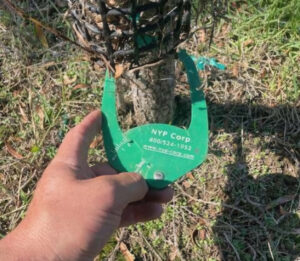
Container Size
Container-grown plants (labeled by the gallon or # sign) are popular due to their lightweight and ease of transport. However, not all container sizes are equal.
- Smaller containers (#1 to #5) generally indicate younger, lighter plants with lower prices.
- Larger containers (#25 and beyond) house more mature plants, which are heavier and more expensive.
The size of the container significantly influences plant growth by determining the amount of space available for root expansion. Smaller containers can limit root development, potentially stunting growth and leading to less vigorous plants.
Conversely, larger containers provide more room for roots to spread, supporting healthier growth and better overall plant stability.
- 1-gallon containers are ideal for quick root establishment and growth. Plants in 1-gallon containers are typically younger, making them easier to manage and faster to grow once planted.
- 3-gallon containers offer the perfect balance between cost and impact. The plants are more mature than their 1-gallon counterparts and offer an immediate visual upgrade to your garden without breaking the bank.
- 25-gallon containers allow for instant gratification since they’re well-established and ready to go. They’ll give your garden an immediate, lush appearance, but they require more effort (and money) to plant initially.
Of course, 1-, 3-, and 25-gallon containers aren’t your only options. However, these are the most popular sizes you’ll find at the vast majority of nurseries.
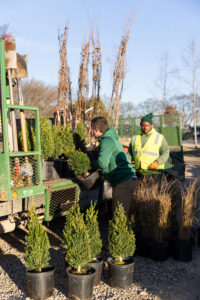
Plant Height
Height measurements are used for shrubs and evergreens larger than 25-gallon containers. This measurement helps homeowners visualize mature plant sizes and plan their landscapes accordingly.
Shrubs and multi-stem trees are often measured by height. Understanding mature plant sizes can prevent overcrowding and ensure proper spacing in your yard.
Here are some examples of how dramatically plant sizes can differ:
- Dwarf Boxwood: Typically reaches a height of 2 to 3 feet, making it ideal for low hedges and borders.
- Japanese Maple: Known for its striking foliage, it usually grows to be about 10 to 25 feet tall, depending on the variety.
- Leyland Cypress: A popular choice for privacy screens, it can grow rapidly to heights of 30 to 50 feet.
- Hydrangea: Varies widely with species, but many types average between 3 to 8 feet tall, suiting them for garden beds and container planting.
If you’re having trouble visualizing how a certain plant will look in your garden, the good news is that there are resources that can help. The Missouri Botanical Garden Plant Finder is a great example. You can research plants by zone, height, color, maintenance needs, and more to find the perfect fit for your space.
And if you’re not sure how or when to plant, this guide from the University of Tennessee-Knoxville is a helpful resource, breaking down when, where, and how to plant any kind of tree you decide you want to grow in your landscape.
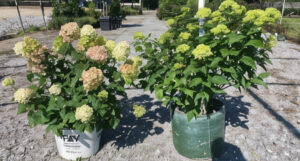
Choosing the Right Container Size
Containers are the most common way nurseries package plants. From 1-gallon pots to 25-gallon containers, these sizes tell you a lot about the plant inside.
To recap, 1-gallon containers are often used for smaller plants and perennials. These containers are ideal for homeowners who want to plant something quickly and see it grow. Smaller containers like these allow for faster root establishment and growth.
3-gallon containers offer a good balance between cost and landscape impact. These are perfect for medium-sized plants that you want to make a statement with but don’t want to spend too much money on. Finally, larger plants often come in 25-gallon containers. These plants can provide instant visual impact, but they also require more care and proper planting techniques to prevent transplant shock.
You might wonder why nurseries standardize certain container sizes while others are rarely available. The industry has found that 1, 3, and 25-gallon sizes offer the best balance of cost, convenience, and plant health.
With that said, here are some tips for choosing the right container size:
- Consider Your Landscape Goals: Think about what you want to achieve with your landscape. Are you looking for instant impact, or are you willing to wait a few years for your plants to grow and fill out?
- Evaluate Your Budget: Larger plants are more expensive, so consider your budget. Smaller plants can offer a more cost-effective way to achieve your landscaping dreams.
- Think About Maintenance: Larger plants require more care and attention to establish. If you’re not willing to put in the extra effort, smaller plants might be a better option.
When you’re considering container size, again, don’t neglect the maximum tree size at planting. The decision about what to plant and where shouldn’t just be focused on the budget but on the climate and your capacity for irrigation. If you can’t provide enough water to a larger tree immediately after you’ve planted (remember, they’ll require much more water at planting time than smaller trees will), then you may want to opt for a smaller specimen.
Similarly, pay attention to variables like site drainage, size larger trees may be poorly suited for wet sites. The roots in the lower parts of the root ball will become submerged in water, which can stress the tree. Don’t forget about weed control and mulch management, either, as these will impact the ideal size of tree to plant.
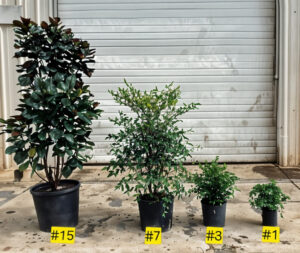
A Note On Standard Container Sizes
It’s also important to note that when we refer to 1-, 3-, and 25-gallon containers, this “gallon” measurement isn’t necessarily the same as a gallon of milk or juice. The term “gallon” is a carryover from the past, when growers used to produce plants in literal milk jugs. They’re still used to describe the sizes of nursery containers but aren’t volumetrically comparable.
Nurseries still rely on these measurements because it’s easy to compare apples to apples. If you find a plant in a 1-gallon container at one nursery and see the same plant in a 1-gallon container at another nearby nursery, you can assume they’re roughly the same size.
Plants that are listed in container sizes are generally raised in those containers, while plants listed by caliper or height are raised in the ground on the farm, growing for years until they become the right size.
Instant Gratification vs. Growth Over Time
Ah, instant gratification – the siren song of landscaping. You walk into a nursery, see those towering trees and mature shrubs, and think, “I want my yard to look like this now!” But hold up. Before you go all-in on those large plants, let’s talk about the science behind plant growth and root establishment.
Believe it or not, smaller plants often adapt better to their environment than their larger, more established counterparts. They grow quicker and often catch up to their larger counterparts in just a few years.
But we get it. The allure of a lush, mature landscape is strong. Larger plants can give you instant visual impact, making your yard look like it’s been curated by professional landscapers. However, they come with their own set of challenges.
Bigger is not always better. For one, smaller trees will be less expensive than those that are well-established. According to more than one source, large trees often have issues that begin early on in production and are exacerbated throughout transit and planting. These issues include a buried root flare (in which soil is piled high over a tree’s roots, and secondary roots eventually kill the main roots).
Other issues include poor root development and girdling, as well as an increased risk of damaged stock in transit – it’s easier for larger root balls to be crushed while they’re being moved.
Smaller stock, on the other hand, might be somewhat tender and delicate at transplant time but will establish into a mature, healthy plant more quickly (without the risks of irreversible damage mentioned above).
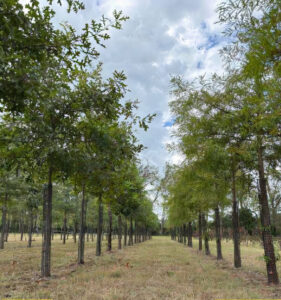
Measurements for Planting and Placement
Okay, you’ve decided to go the smart route and opt for smaller plants. Now what? Let’s talk about how to measure trees for planting and placement to avoid future headaches.
Distance from Home – Avoiding Root and Branch Nightmares
One of the biggest mistakes homeowners make is planting trees and shrubs too close to their homes. This can lead to a host of problems, including root damage to your foundation and septic system and branches that encroach on your space.
You also need to watch out for other issues, like how much shadow the tree will cast and whether the tree will ultimately grow into a power line or street. Even trees that have branches extending into your neighbor’s yard can be problematic.
Do your research ahead of time to get an idea about how large the mature tree will be, not just above ground (with its branches), but also below ground (with its roots).
There’s no single best recommendation for how far away you should plant trees from your home. It depends on the mature size of the tree, as well as its pattern of branching.
Planning for Growth – Think Big, Plant Smart
When you’re planning your landscape, again, consider the mature size of your plants. Trust us, you don’t want to plant a tree that looks perfect now only to have it grow into a behemoth that overtakes your entire yard.
Check the plant labels to get an idea of how big they’ll ultimately grow. You can also use this resource for planning a landscape, which takes into consideration not only the new species you’re planting but also existing structures and plants.
This video can also serve as a helpful guide as you go about figuring out the right planting distances for your new trees.
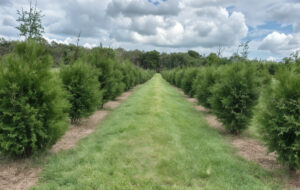
The Takeaway
Understanding nursery stock sizes and how to properly plant and care for them can make a world of difference for your landscape. By choosing smaller plants, planning for growth, and following best practices for planting and care, you can create a beautiful and sustainable garden that will thrive for years to come.
For personalized advice and expert help, consider reaching out to a local landscape professional in Gallatin, TN, like the ones at the Tennessee Nursery and Landscape Association. They can guide you in selecting the best plants and placements for your property.
Of course, our team at Puryear Farms is here to help you make the right choice, too. Although we don’t sell nursery stock to the general public, we do have a nursery (meaning we have some hands-on knowledge about which trees – and which tree sizes – work well in our local area). We’re happy to answer any questions you might have.
Hopefully, this guide has helped clear up any of the confusion you might have had about nursery stock sizes, but don’t hesitate to reach out if you’re still feeling lost.
Ready to get started with planting trees? Schedule a consultation with a trusted nursery and start creating a picture-perfect landscape today!

